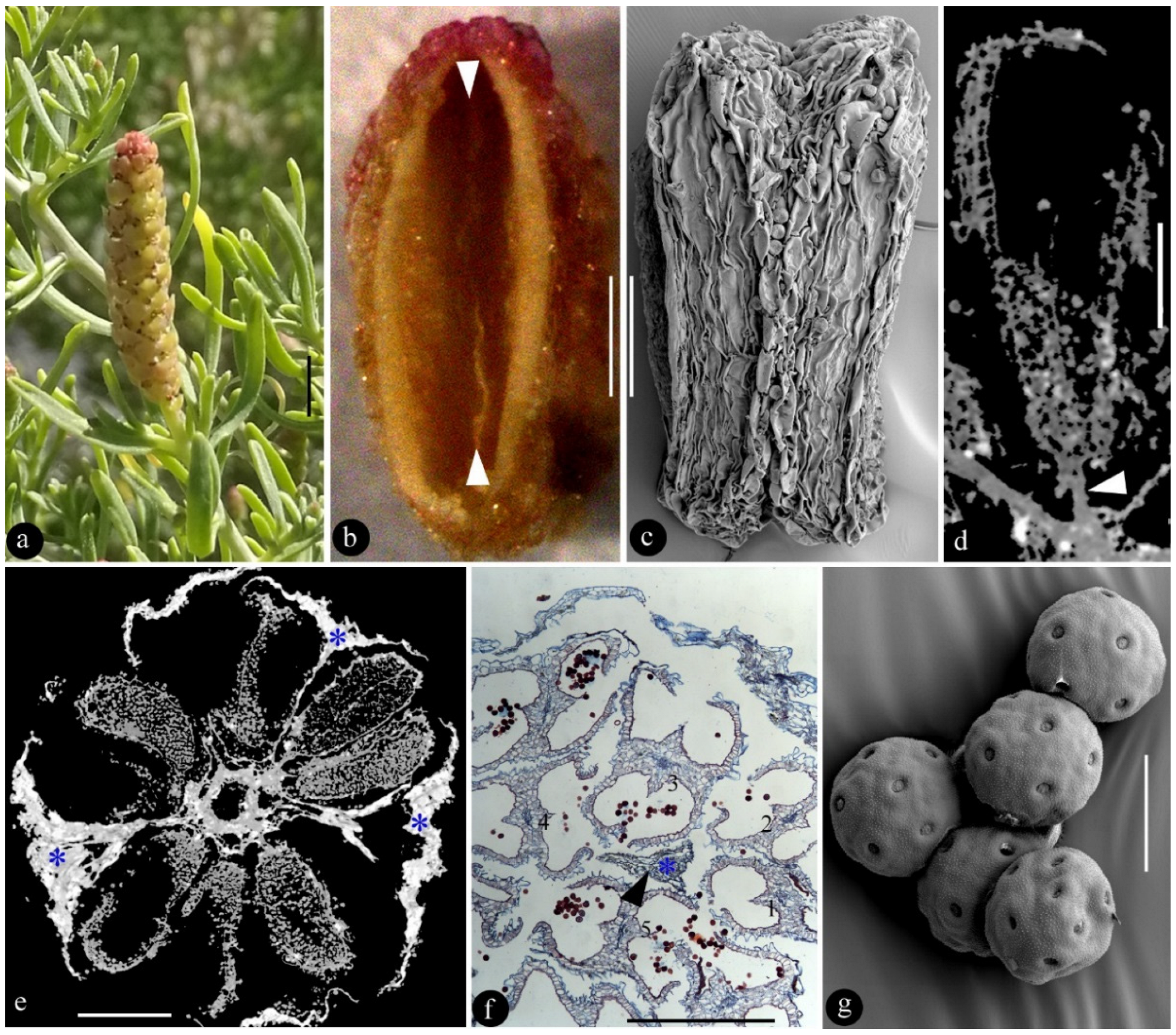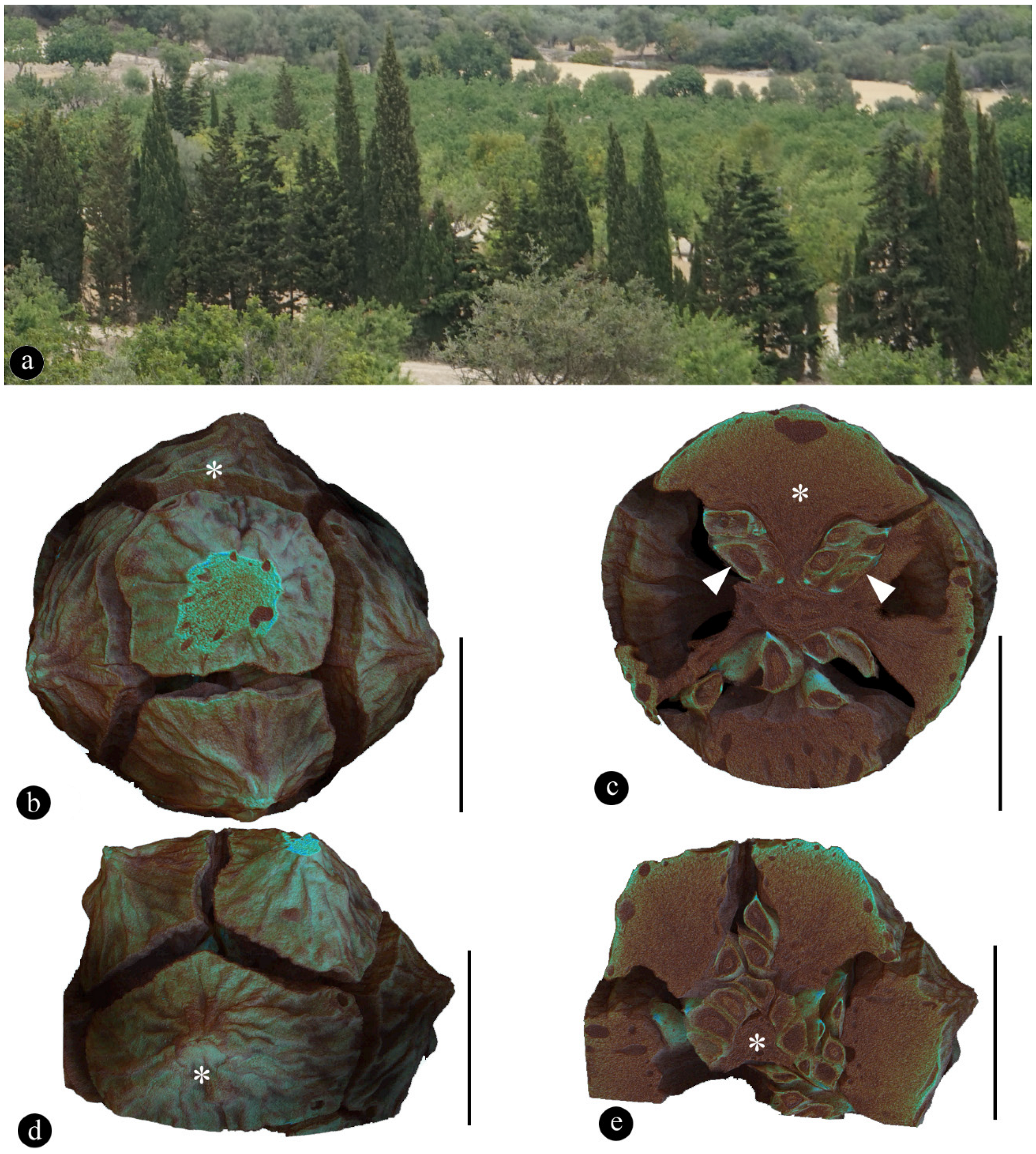Unique Morphology of Sarcobatus baileyi Male Inflorescence and Its Botanical Implications
Abstract
1. Introduction
2. Materials and Methods
3. Results
4. Discussion
5. Conclusions
Author Contributions
Funding
Institutional Review Board Statement
Informed Consent Statement
Data Availability Statement
Acknowledgments
Conflicts of Interest
References
- Wang, X.; Duan, S.; Geng, B.; Cui, J.; Yang, Y. Schmeissneria: A missing link to angiosperms? BMC Evol. Biol. 2007, 7, 14. [Google Scholar] [CrossRef] [PubMed]
- Wang, X.; Shih, C.; Liu, Z.-J.; Lin, L.; Singh, K.J. Reconstructing the Callianthus plant–An early aquatic angiosperm from the Lower Cretaceous of China. Cretac. Res. 2021, 128, 104983. [Google Scholar] [CrossRef]
- Wang, X. The Dawn Angiosperms, 2nd ed.; Springer: Cham, Switzerland, 2018; p. 407. [Google Scholar]
- Han, G.; Liu, Z.; Wang, X. A Dichocarpum-like angiosperm from the Early Cretaceous of China. Acta Geol. Sin. (Engl. Ed.) 2017, 90, 1–8. [Google Scholar]
- Han, G.; Liu, Z.-J.; Liu, X.; Mao, L.; Jacques, F.M.B.; Wang, X. A whole plant herbaceous angiosperm from the Middle Jurassic of China. Acta Geol. Sin. (Engl. Ed.) 2016, 90, 19–29. [Google Scholar]
- Liu, Z.-J.; Wang, X. A perfect flower from the Jurassic of China. Hist. Biol. 2016, 28, 707–719. [Google Scholar] [CrossRef] [PubMed]
- Liu, Z.-J.; Wang, X. Yuhania: A unique angiosperm from the Middle Jurassic of Inner Mongolia, China. Hist. Biol. 2017, 29, 431–441. [Google Scholar] [CrossRef] [PubMed]
- Liu, Z.-J.; Wang, X. A novel angiosperm from the Early Cretaceous and its implications on carpel-deriving. Acta Geol. Sin. (Engl. Ed.) 2018, 92, 1293–1298. [Google Scholar] [CrossRef]
- Santos, A.A.; Wang, X. Pre-Carpels from the Middle Triassic of Spain. Plants 2022, 11, 2833. [Google Scholar] [CrossRef]
- Fu, Q.; Diez, J.B.; Pole, M.; Garcia-Avila, M.; Liu, Z.-J.; Chu, H.; Hou, Y.; Yin, P.; Zhang, G.-Q.; Du, K.; et al. An unexpected noncarpellate epigynous flower from the Jurassic of China. eLife 2018, 7, e38827. [Google Scholar] [CrossRef]
- Fu, Q.; Hou, Y.; Yin, P.; Diez, J.B.; Pole, M.; García-Ávila, M.; Wang, X. Micro-CT results exhibit ovules enclosed in the ovaries of Nanjinganthus. Sci. Rep. 2023, 13, 426. [Google Scholar] [CrossRef] [PubMed]
- Friis, E.M.; Crane, P.R.; Pedersen, K.R. The Early Flowers and Angiosperm Evolution; Cambridge University Press: Cambridge, UK, 2011; p. 596. [Google Scholar]
- Canright, J.E. The comparative morphology and relationships of the Magnoliaceae. III. Carpels. Am. J. Bot. 1960, 47, 145–155. [Google Scholar] [CrossRef]
- Sattler, R.; Lacroix, C. Development and evolution of basal cauline placentation: Basella rubra. Am. J. Bot. 1988, 75, 918–927. [Google Scholar] [CrossRef]
- Retallack, G.; Dilcher, D.L. Early angiosperm reproduction: Prisca reynoldsii, gen. et sp. nov. from the mid-Cretaceous coastal deposits in Kansas, U.S.A. Paläontogr. B 1981, 179, 103–107. [Google Scholar]
- Retallack, G.; Dilcher, D.L. A coastal hypothesis for the dispersal and rise to dominance of flowering plants. In Paleobotany, Paleoecology and Evolution; Niklas, K.J., Ed.; Praeger Publishers: New York, NY, USA, 1981; pp. 27–77. [Google Scholar]
- Retallack, G.; Dilcher, D.L. Arguments for a glossopterid ancestry of angiosperms. Paleobiology 1981, 7, 54–67. [Google Scholar] [CrossRef]
- Melville, R. A new theory of the angiosperm flower: I. The gynoecium. Kew Bull. 1962, 16, 1–50. [Google Scholar] [CrossRef]
- Melville, R. A new theory of the angiosperm flower: II. The androecium. Kew Bull. 1963, 17, 1–63. [Google Scholar] [CrossRef]
- Melville, R. The origin of flowers. New Sci. 1964, 22, 494–496. [Google Scholar]
- Meeuse, A.D.J. From ovule to ovary: A contribution to the phylogeny of the megasporangium. Acta Biotheor. 1963, 16, 127–182. [Google Scholar] [CrossRef]
- Meeuse, A.D.J. Angiosperm phylogeny, floral morphology and pollination ecology. Acta Biotheor. 1972, 21, 145–166. [Google Scholar] [CrossRef]
- Ma, Q.; Zhang, W.; Xiang, Q.-Y. Evolution and developmental genetics of floral display-A review of progress. J. Syst. Evol. 2017, 55, 487–515. [Google Scholar] [CrossRef]
- Dreni, L.; Zhang, D. Flower development: The evolutionary history and functions of the AGL6 subfamily MADS-box genes. J. Exp. Bot. 2016, 67, 1625–1638. [Google Scholar] [CrossRef]
- Skinner, D.J.; Hill, T.A.; Gasser, C.S. Regulation of ovule development. Plant Cell 2004, 16, S32–S45. [Google Scholar] [CrossRef] [PubMed]
- Mathews, S.; Kramer, E.M. The evolution of reproductive structures in seed plants: A re-examination based on insights from developmental genetics. New Phytol. 2012, 194, 910–923. [Google Scholar] [CrossRef]
- Roe, J.L.; Nemhauser, J.L.; Zambryski, P.C. TOUSLED participates in apical tissue formation during gynoecium development in Arabidopsis. Plant Cell 1997, 9, 335–353. [Google Scholar] [PubMed]
- Rounsley, S.D.; Ditta, G.S.; Yanofsky, M.F. Diverse roles for MADS box genes in Arabidopsis development. Plant Cell 1995, 7, 1259–1269. [Google Scholar] [PubMed]
- Cronquist, A. The Evolution and Classification of Flowering Plants, 2nd ed.; New York Botanical Garden: New York, NY, USA, 1988; p. 555. [Google Scholar]
- APG. APG IV: An update of the Angiosperm Phylogeny Group classification for the orders and families of flowering plants. Bot. J. Linn. Soc. 2016, 181, 1–20. [Google Scholar] [CrossRef]
- Bai, S.N.; Xu, Z.H. Unisexual cucumber flowers, sex and sex differentiation. In International Review of Cell and Molecular Biology; Jeon, K., Ed.; Academic Press: Amsterdam, The Netherlands, 2013; Volume 304, pp. 1–56. [Google Scholar]
- Posluszny, U.; Tomlinson, P.B. Aspects of inflorescence and floral development in the putative basal angiosperm Amborella trichopoda (Amborellaceae). Can. J. Bot. 2003, 81, 28–39. [Google Scholar] [CrossRef]
- Behnke, H.-D. Sarcobataceae—A new family of Caryophyllales. Taxon 1997, 46, 495–507. [Google Scholar] [CrossRef]
- Jepson, W.L. A Manual of the Flowering Plants of California; University of California Press: Berkeley, CA, USA, 1951; p. 1238. [Google Scholar]
- Munz, P.A.; Keck, D.D. A California Flora; University of California Press: Berkeley, CA, USA, 1959. [Google Scholar]
- Khan, M.A.; Gul, B.; Weber, D.J. Seed germination in relation to salinity and temperature in Sarcobatus vermiculatus. Biol. Plant. 2001, 45, 133–135. [Google Scholar] [CrossRef]
- Sanderson, S.C.; Stutz, H.C.; Stutz, M.; Roos, R.C. Chromosome races in Sarcobatus (Sarcobataceae, Caryophyllales). Great Basin Nat. 1999, 59, 301–314. [Google Scholar]
- Baillon, H.E. Développement de la fleur femelle du Sarcobatus. Bull. Soc. Linn. Paris 1887, 1, 649. [Google Scholar]
- Tomlinson, P.B.; Takaso, T. Seed cone structure in conifers in relation to development and pollination: A biological approach. Can. J. Bot. 2002, 80, 1250–1273. [Google Scholar] [CrossRef]
- Zhou, Z.; Yang, X.; Wu, X. Ginkgophytes; Science Press: Beijing, China, 2020; p. 458. [Google Scholar]
- Martens, P. Les Gnetophytes; Gebrueder Borntraeger: Berlin, Germany, 1971. [Google Scholar]
- Zavada, M.S.; Crepet, W.L. Pollen grain wall structure of Caytonanthus arberi (Caytoniales). Plant Syst. Evol. 1986, 153, 259–264. [Google Scholar] [CrossRef]
- Taylor, T.N.; Taylor, E.L.; Krings, M. Paleobotany: The Biology and Evolution of Fossil Plants, 2nd ed.; Elsevier: Amsterdam, The Netherlands, 2009; p. 1230. [Google Scholar]
- Farjon, A. A Monograph of Cupressaceae and Sciadopitys; Royal Botanic Gardens, Kew: Richmond, UK, 2005. [Google Scholar]
- Crane, P.R. The morphology and relationships of the Bennettitales. In Systematic and Taxonomic Approaches in Palaeobotany; Spicer, R.A., Thomas, B.A., Eds.; The Systematics Association Special Volume; Clarendon Press: Oxford, UK, 1986; Volume 31, pp. 163–175. [Google Scholar]
- Fu, Q.; Liu, J.; Wang, X. Offspring development conditioning (ODC): A universal evolutionary trend in sexual reproduction of organisms. J. Northwest Univ. (Nat. Sci. Ed.) 2021, 51, 163–172. [Google Scholar] [CrossRef]
- Rothwell, G.W.; Stockey, R.A. Independent evolution of seed enclosure in the bennettitales: Evidence from the anatomically preserved cone Foxeoidea connatum gen. et sp. nov. In Plants in the Mesozoic Time: Innovations, Phylogeny, Ecosystems; Gee, C.T., Ed.; Indiana University Press: Bloomington, IN, USA, 2010; pp. 51–64. [Google Scholar]
- Rothwell, G.W.; Stockey, R.A. Anatomically preserved Cycadeoidea (Cycadeoidaceae), with a reevaluation of systematic characters for the seed cones of Bennettitales. Am. J. Bot. 2002, 89, 1447–1458. [Google Scholar] [CrossRef] [PubMed]
- Rothwell, G.W.; Crepet, W.L.; Stockey, R.A. Is the anthophyte hypothesis alive and well? New evidence from the reproductive structures of Bennettitales. Am. J. Bot. 2009, 96, 296–322. [Google Scholar] [CrossRef] [PubMed]
- Jagel, A.; Dörken, V.M. Morphology and morphogenesis of the seed cones of the Cupressaceae—Part II: Cupressoideae. Bull. Cupressus Conserv. Proj. 2015, 4, 51–78. [Google Scholar]
- Schulz, C.; Jagel, A.; Stützel, T. Cone morphology in Juniperus in the light of cone evolution in Cupressaceae s.l. Flora 2003, 198, 161–177. [Google Scholar] [CrossRef]
- Bai, S.N. Are unisexual flowers an appropriate model to study plant sex determination? J. Exp. Bot. 2020, 71, 4625–4628. [Google Scholar] [CrossRef]
- Sauquet, H.; von Balthazar, M.; Magallón, S.; Doyle, J.A.; Endress, P.K.; Bailes, E.J.; Barroso de Morais, E.; Bull-Hereñu, K.; Carrive, L.; Chartier, M.; et al. The ancestral flower of angiosperms and its early diversification. Nat. Commun. 2017, 8, 16047. [Google Scholar] [CrossRef]


Disclaimer/Publisher’s Note: The statements, opinions and data contained in all publications are solely those of the individual author(s) and contributor(s) and not of MDPI and/or the editor(s). MDPI and/or the editor(s) disclaim responsibility for any injury to people or property resulting from any ideas, methods, instructions or products referred to in the content. |
© 2023 by the authors. Licensee MDPI, Basel, Switzerland. This article is an open access article distributed under the terms and conditions of the Creative Commons Attribution (CC BY) license (https://creativecommons.org/licenses/by/4.0/).
Share and Cite
Liu, W.; Xu, X.; Wang, X. Unique Morphology of Sarcobatus baileyi Male Inflorescence and Its Botanical Implications. Plants 2023, 12, 1917. https://doi.org/10.3390/plants12091917
Liu W, Xu X, Wang X. Unique Morphology of Sarcobatus baileyi Male Inflorescence and Its Botanical Implications. Plants. 2023; 12(9):1917. https://doi.org/10.3390/plants12091917
Chicago/Turabian StyleLiu, Wenzhe, Xiuping Xu, and Xin Wang. 2023. "Unique Morphology of Sarcobatus baileyi Male Inflorescence and Its Botanical Implications" Plants 12, no. 9: 1917. https://doi.org/10.3390/plants12091917
APA StyleLiu, W., Xu, X., & Wang, X. (2023). Unique Morphology of Sarcobatus baileyi Male Inflorescence and Its Botanical Implications. Plants, 12(9), 1917. https://doi.org/10.3390/plants12091917






